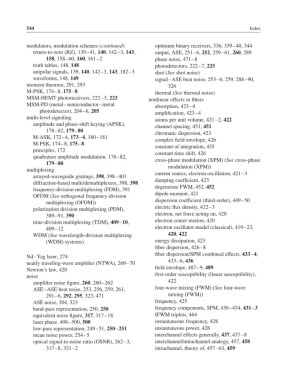Page 563 - Fiber Optic Communications Fund
P. 563
544 Index
modulators, modulation schemes (continued) optimum binary receivers, 336, 339–40, 344
return-to-zero (RZ), 139–41, 140, 142–3, 143, output, ASE, 251–6, 252, 259–61, 260, 289
158, 158–60, 160, 161–2 phase noise, 471–8
truth tables, 148, 148 photodetectors, 222–7, 225
unipolar signals, 139, 140, 142–3, 143, 182–3 shot (See shot noise)
waveforms, 148, 149 signal–ASE beat noise, 253–6, 259, 288–90,
moment theorem, 291, 293 326
M-PSK, 174–8, 175–8 thermal (See thermal noise)
MSM-HEMT photoreceivers, 222–3, 223 nonlinear effects in fibers
MSM-PD (metal–semiconductor–metal absorption, 423–4
photodetector), 204–6, 205 amplification, 423–4
multi-level signaling
atoms per unit volume, 421–2, 422
amplitude and phase-shift keying (APSK),
channel spacing, 451, 451
178–82, 179–80
chromatic dispersion, 423
M-ASK, 172–4, 173–4, 180–181
complex field envelope, 426
M-PSK, 174–8, 175–8
constant of integration, 435
principles, 172
constant time shift, 426
quadrature amplitude modulation, 178–82,
cross-phase modulation (XPM) (See cross-phase
179–80
modulation (XPM))
multiplexing
current source, electron oscillation, 421–3
arrayed-waveguide gratings, 398, 398–401
damping coefficient, 423
diffraction-based multi/demultiplexers, 398, 398
degenerate FWM, 452, 452
frequency-division multiplexing (FDM), 391
dipole moment, 421
OFDM (See orthogonal frequency-division
dispersion coefficient (third-order), 449–50
multiplexing (OFDM))
electric flux density, 422–3
polarization division multiplexing (PDM),
electron, net force acting on, 420
389–91, 390
time-division multiplexing (TDM), 409–10, electron center motion, 420
409–12 electron oscillator model (classical), 419–23,
WDM (See wavelength-division multiplexing 420, 422
(WDM) systems) energy dissipation, 423
fiber dispersion, 426–8
fiber dispersion/SPM combined effects, 433–4,
Nd–Yag laser, 274
433–6, 436
nearly traveling-wave amplifier (NTWA), 269–70
field envelope, 487–9, 489
Newton’s law, 420
first-order susceptibility (linear susceptibility),
noise
amplifier noise figure, 260, 260–262 422
ASE–ASE beat noise, 253, 256, 259, 261, four-wave mixing (FWM) (See four-wave
291–6, 292, 295, 323, 471 mixing (FWM))
ASE noise, 304, 323 frequency, 425
band-pass representation, 250, 250 frequency components, SPM, 430–434, 431–3
equivalent noise figure, 317, 317–18 IFWM triplets, 464
laser phase, 498–500, 500 instantaneous frequency, 428
low-pass representation, 249–51, 250–251 instantaneous power, 428
mean noise power, 254–5 interchannel effects generally, 437, 437–8
optical signal-to-noise ratio (OSNR), 262–3, interchannel/intrachannel analogy, 457, 458
317–8, 321–2 intrachannel, theory of, 457–63, 459

